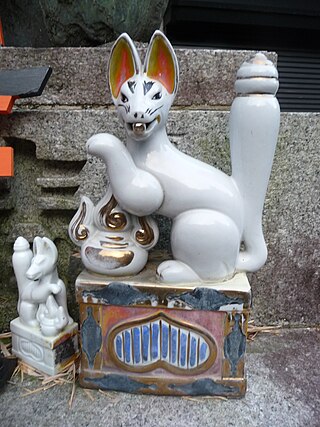Karen Ann Smyers (born October 31, 1954) is an American academic with a special interest in Japan. [1] She has also developed a second career as a Jungian analyst. [2]
Smyers earned her undergraduate degree at Smith College and she earned her Ph.D. in Anthropology from Princeton University. [2] Her doctoral thesis was entitled "The fox and the jewel: a study of shared and private meanings in Japanese Inari worship." [3] She is known as an expert on Inari Ōkami and Inari-related literature.
Smyers taught in the Religion Department at Wesleyan University. [2]
In 2001, Smyers enrolled in the Jung Institute in Zürich, Switzerland. In 2007, she was awarded a diploma from the International School of Analytical Psychology (ISAP). She established a practice as a Jungian analyst in Hadley, Massachusetts. [2]
Smyers became the President of the Western Massachusetts Association of Jungian Psychology. [2]
In a statistical overview derived from writings by and about Karen Ann Smyers, OCLC/WorldCat encompasses roughly 3 works in 10+ publications in 1 language and 300+ library holdings. [4]

In Japanese folklore, kitsune are foxes that possess paranormal abilities that increase as they get older and wiser. According to folklore, the kitsune-foxes can bewitch people, just like the tanuki they have the ability to shapeshift into human or other forms, and to trick or fool human beings. While some folktales speak of kitsune employing this ability to trick others—as foxes in folklore often do—other stories portray them as faithful guardians, friends, and lovers.

Magatama are curved, comma-shaped beads that appeared in prehistoric Japan from the Final Jōmon period through the Kofun period, approximately 1000 BCE to the 6th century CE. The beads, also described as "jewels", were made of primitive stone and earthen materials in the early period, but by the end of the Kofun period were made almost exclusively of jade. Magatama originally served as decorative jewelry, but by the end of the Kofun period functioned as ceremonial and religious objects.

Inari Ōkami, also called Ō-Inari (大稲荷), is the Japanese kami of foxes, fertility, rice, tea and sake, agriculture and industry, and general prosperity and worldly success, and is one of the principal kami of Shinto. The name Inari can be literally translated into "rice-bearer". In earlier Japan, Inari was also the patron of swordsmiths and merchants. Alternatingly-represented as male and/or female, Inari is sometimes seen as a collective of three or five individual kami. Inari appears to have been worshipped since the founding of a shrine at Inari Mountain in 711 CE, although some scholars believe that worship started in the late 5th century.

A ḍākinī is a type of female spirit, goddess, or demon in Hinduism and Buddhism.

Fushimi Inari-taisha is the head shrine of the kami Inari, located in Fushimi-ku, Kyoto, Kyoto Prefecture, Japan. The shrine sits at the base of a mountain, also named Inari, which is 233 metres (764 ft) above sea level, and includes trails up the mountain to many smaller shrines which span 4 kilometres (2.5 mi) and take approximately 2 hours to walk up. It is unclear whether the mountain's name, Inariyama, or the shrine's name came first.

The Japanese term shinbutsu bunri (神仏分離) indicates the separation of Shinto from Buddhism, introduced after the Meiji Restoration which separated Shinto kami from buddhas, and also Buddhist temples from Shinto shrines, which were originally amalgamated. It is a yojijukugo phrase.

In Japan, myōbu (命婦) is a title which was given to ladies of the fifth rank in the imperial court or to midrank noblewomen. In The Pillow Book, Lady Myōbu was also the name of a pet cat belonging to Empress Consort Sadako, whom the author Sei Shōnagon served.

In Shinto shrine architecture, the honden, also called shinden (神殿), or sometimes shōden (昇殿) as in Ise Shrine's case, is the most sacred building at a Shinto shrine, intended purely for the use of the enshrined kami, usually symbolized by a mirror or sometimes by a statue. The building is normally in the rear of the shrine and closed to the general public. In front of it usually stands the haiden, or oratory. The haiden is often connected to the honden by a heiden, or hall of offerings.
An Inari shrine is a type of Japanese shrine used to worship the kami Inari. Inari is a popular deity associated with foxes, rice, household wellbeing, business prosperity, and general prosperity. Inari shrines are typically constructed of white stucco walls with red-lacquered woodwork, and their entrances are marked by vermilion torii. Both Buddhist and Shinto Inari shrines are located throughout Japan.
The Japanese word mitama refers to the spirit of a kami or the soul of a dead person. It is composed of two characters, the first of which, mi, is simply an honorific. The second, tama (魂・霊) means "spirit". The character pair 神霊, also read mitama, is used exclusively to refer to a kami's spirit. Significantly, the term mitamashiro is a synonym of shintai, the object which in a Shinto shrine houses the enshrined kami.

The Takekoma Inari Shrine (竹駒稲荷神社) is a Shintō shrine in the city of Iwanuma in Miyagi Prefecture, Japan. It is considered one of the three main shrines dedicated to the kami Inari, and claims to be the second-oldest Inari shrine in Japan. It was also referred to as the Takekoma Myojin (武隈明神)

Komainu (狛犬), often called lion-dogs in English, are statue pairs of lion-like creatures, which traditionally guard the entrance or gate of the shrine, or placed in front of or within the honden of Japanese Shinto shrines.

Hanazono University is a private university in Kyoto, Japan that belongs to the Rinzai sect. The university and the neighborhood are named for Emperor Hanazono, whose donated his palace to make Myōshin-ji.

Kanjō (勧請) in Shinto terminology indicates a propagation process through which a kami, previously divided through a process called bunrei, is invited to another location and there re-enshrined.
Bunrei or wakemitama (分霊) is a Shinto technical term that indicates both the process of dividing a Shinto kami to be re-enshrined somewhere else, and the spirit itself produced by the division. Shrines conduct bunrei to distribute them to "child" shrines elsewhere. The spirit of kami does not decrease through this act, and a bunrei functions the same way as the original spirit. The reason for conducting bunrei is often to make a kami more accessible to worshipers far from the main shrine.
Kokkuri or Kokkuri-san (こっくりさん) is a Japanese game popular during the Meiji era that is also a form of divination, partially based on Western table-turning. The name kokkuri is an onomatopoeia meaning "to nod up and down", and refers to the movement of the actual kokkuri mechanism. The kanji used to write the word is an ateji, although its characters reflect the popular belief that the movement of the mechanism is caused by supernatural agents. The modern version is similar to a Ouija board.

Myōgon-ji (妙厳寺), also known as Toyokawa Inari, is a Sōtō Zen Buddhist temple located in the city of Toyokawa in eastern Aichi Prefecture, Japan.

In Shinto, shintai, or go-shintai when the honorific prefix go- is used, are physical objects worshipped at or near Shinto shrines as repositories in which spirits or kami reside. Shintai used in Shrine Shinto can be also called mitamashiro.

In Japan, a chinjusha is a Shinto shrine which enshrines a tutelary kami; that is, a patron spirit that protects a given area, village, building or a Buddhist temple. The Imperial Palace has its own tutelary shrine dedicated to the 21 guardian gods of Ise Shrine. Tutelary shrines are usually very small, but there is a range in size, and the great Hiyoshi Taisha for example is Enryaku-ji's tutelary shrine. The tutelary shrine of a temple or the complex the two together form are sometimes called a temple-shrine. If a tutelary shrine is called chinju-dō, it is the tutelary shrine of a Buddhist temple. Even in that case, however, the shrine retains its distinctive architecture.

Shinshi are animals in Japanese mythology that are believed to be associated with a kami, a divine being. These animals are also known as kami no tsukai or tsukawashime. In ancient texts such as Kojiki and Nihongi, there are tales of special animals that acted on behalf of the kami to transmit the divine will or to bear oracles.